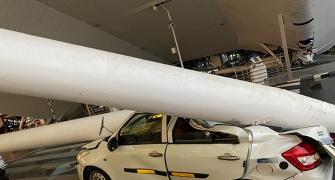Are faulty design, hurried construction and private ownership to be blamed for the incidents of airport roofs crashing?

Indian aviation took a hit on June 28, 2024, with the collapse of a canopy and a huge metal beam at Terminal 1 at the Indira Gandhi international airport in Delhi during heavy rain.
The same day, a roof canopy at Jabalpur's Dumna airport collapsed after heavy rains, damaging a car. Shockingly, the next day, a canopy outside Rajkot airport also collapsed amid heavy rain.
Ironically, these incidents happened even as news reports proclaimed that the Indian aviation sector had surpassed Brazil and Indonesia to become the third largest domestic aviation market.
The government has earmarked around $11 billion to build new airports and refurbish others to have some 200 airports within five years, but the question is how solid are these structures?
Videos of cars crushed at Delhi airport under the huge beam were horrifying.
The terminal had recently been expanded to reach a capacity of 40 million passengers annually. So why should a building collapse when aerodromes are meant to weather many storms for many years?
Even more ironic was the fact that Skytrax's World's Top Airports of 2024, voted by customers globally, gave Delhi the award for the best airports in India/South Asia 2024.
Skytrax is a reputed international air transport rating organisation in London, but the Delhi incident has led critics to question its credibility too.

Collapsing roofs at Indian airports are not new. Guwahati airport and the Veer Savarkar international airport in Port Blair too have had similar incidents.
While allegations of corruption are hurled between political parties over them, former aviation minister Praful Patel said that the Delhi structure built under his watch was 'made by one of the best construction companies in the country, possibly the world'.
Then why did it collapse on the first day of the monsoon season? Patel added: 'See... now talking about a structure that was built 15 years ago... and which has seen such extensive usage...'
However, Jose Kurian, a veteran structural engineer and project adviser, Kerala Infrastructure Investment Fund Board, and Chairman, Civil Engineering Division Council of BIS, Delhi, said that in India, public structures should be designed to last 75 years.
"I was involved in the building of Signature Bridge in Delhi and it is designed to last 100 years. We had engaged competent structural engineers and third party quality auditors in its construction," says Kurian.
"Lajpat Nagar Flyover and the underpass, which too I was involved in, were done with a design life of 75 years using Indian Standards and have systems provided for proper drainage for heavy monsoons. It goes without any doubt that they have to be maintained and audited periodically by the operating agencies," Kurian added.

Kurian said the handing over of government structures, such as airports, primarily to avoid delays and improve operational efficiency to the private sector have, however, relaxed oversight by independent agencies.
"In the government, there are multiple oversights and audits, which are often missing in the private sector. Secondly, speed is of the essence and corners are cut and eyes closed over deficiencies. Thirdly, maintenance is often neglected in a bid to save money," Kurian said.
Kurian guesses that at T1, the canopy could have collapsed suddenly due to accumulation of water because of the heavy downpour, leading to the beam falling without any warning signs.
Fabrication could also be the culprit. "Welders too need to be qualified. A forensic audit should be done of the airport by an independent agency. In general, the engineering profession should be regulated through compulsory registration just like lawyers and doctors," he added.

India is not alone as far as airport calamities go. On January 26, 2022, following a blizzard, an airport cargo warehouse roof in Istanbul collapsed. Thousands were left stranded as flights were cancelled.
In many cases, it is faulty design to blame. Take the March 23, 2004, incident at the Charles De Gaulle airport's Terminal 2E in Paris, which killed four and injured three.
Here, the ceiling cracked and crashed. Mark Finlay and Tatenda Karuwa write in Simple Flying that engineers speculated that the terminal's futuristic design, lacking internal roof supports, contributed to the collapse.
A year later, a final report cited the following flaws: Lack of redundant supports, poorly spaced reinforced steel, weak concrete support beams and low resilience to temperature.
The terminal was demolished and rebuilt using a more traditional glass and steel structure, and opened on March 30, 2008.

There have been other airport design flaws. A June 2022 paper on Critical Analysis of Existing Airports' Designs by Armand Brzosko, a design engineer and a commercial pilot, said that certain particularities of aviation cause noticeable competence gap by the designers.
'Architects act within a space defined by building codes and standards... and are specialists only for narrow sections of it, and often not capable of reaching out to the neighbouring section,' he said.
'As a result, by the design of the airport terminal, a building wall becomes an interface where the architect ends his function, relaying -- with relief -- the function to the aerodrome designer, who -- in turn -- is less familiar with intricacies of floors, beams, stairs, slabs, etc,' wrote Brzoska.
He reveals defects in different parts of airports. Take aerobridges. They often bear all traits of a palliative, temporary, makeshift solution -- more or less comparable to a board thrown across the stream.
They serve only one of a few aircraft doors; they are costly and ugly; unfitting to any architectural style, Brzoska said.
Similarly, almost no terminal floor has heights capable of solving the relatively simple problem of delivering passengers from/to various floors.
'As a result, we have terminals with exceedingly high, cathedral range ceilings in departure halls, e.g. 60 m in one newly built airport. This is contrasted with claustrophobically low arrival halls,' he wrote.
Aerodromes are built for hundred years and therefore, architects and engineers 'require an out-of-the-box, cross-field approach,' Broska concluded.
With IIT-Delhi structural engineers now being roped in by the government, it waits to been seen what their findings will be for the GMR-led Delhi airport.
Curtis W Fentress, founder and principal in charge of Design of Fentress Architects, wrote in Building Enclosure, a Web site, that most futuristic terminals will be multi-layered hyperspaces designed to create a unique sense of place in their location.
One of the airports Fentress designed was Denver international airport's Jeppesen terminal, which has the world's largest structurally integrated tensile membrane roof.
The double-layer fabric roof is composed of an outer waterproof membrane of Teflon PTFE-coated fibreglass, and an interior one of uncoated fibreglass.
The fibreglass increases durability for high-wind applications and reduces construction and maintenance costs.
While most conventional roofing systems are replaced every 10 to 15 years, the proven service life of a PTFE fibreglass roof is over 30 years, he said.
Perhaps India can learn from these airport designs to lessen airport accidents from heavy rain and wind.
Shobha John is a senior journalist.
Feature Presentation: Rajesh Alva/Rediff.com









